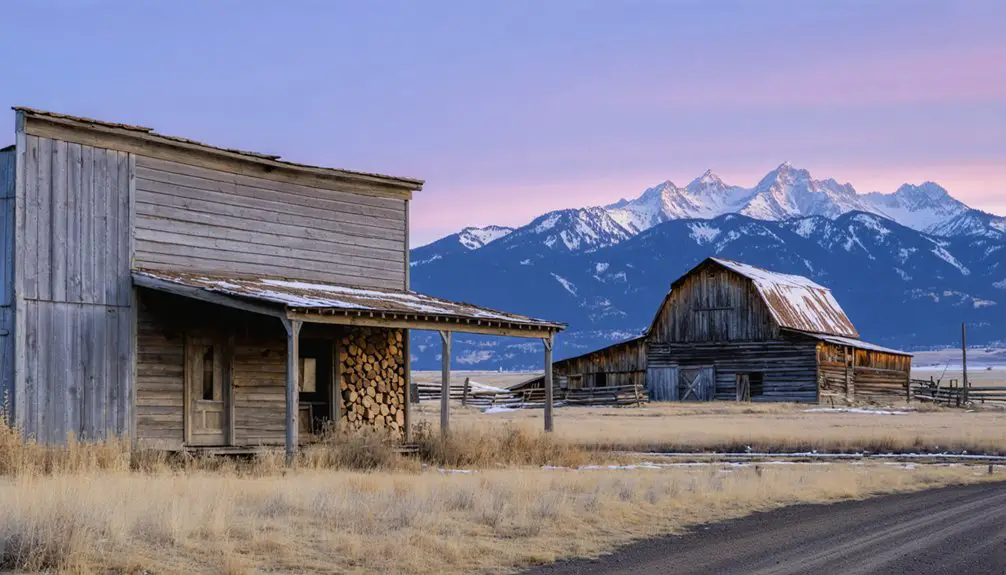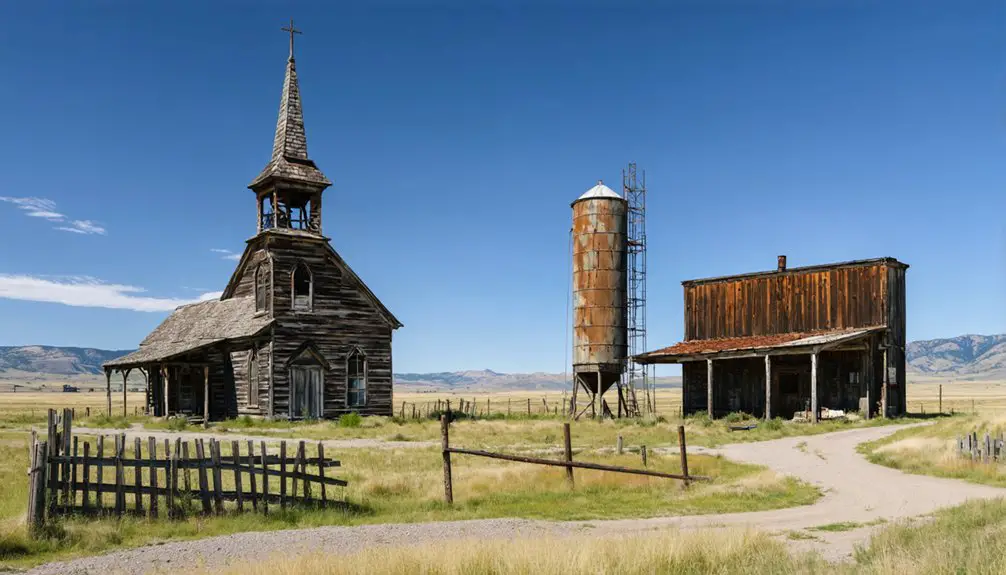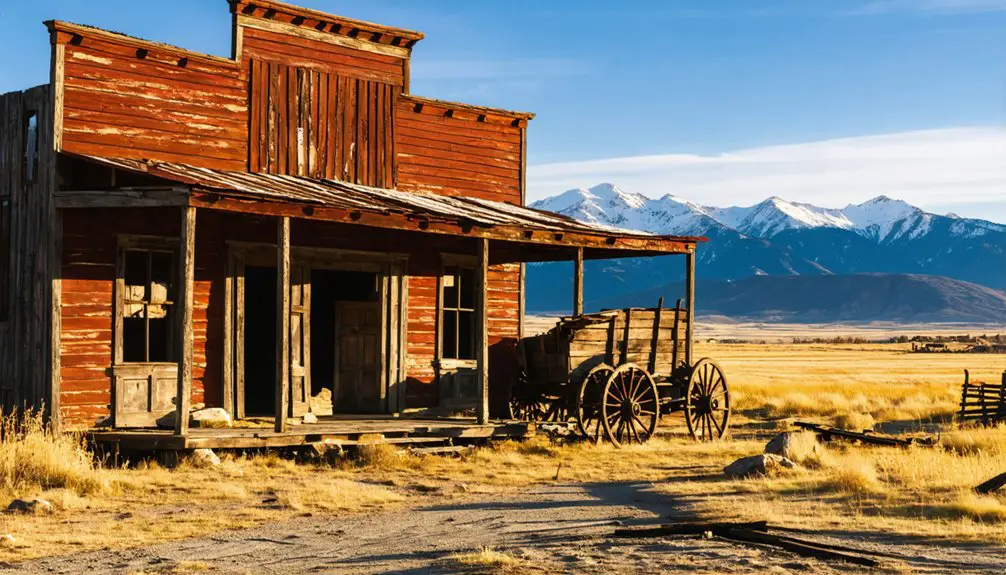When you visit Lennep today, you’ll find a rare ghost town that still pulses with life through its historic Trinity Lutheran Church, established in 1891 by Norwegian pioneers. The remote Montana settlement, founded by Martin T. Grande in the 1870s, flourished as a Milwaukee Road railroad stop and sheep ranching hub. While most buildings stand quiet now, twice-monthly services at the preserved Gothic Revival church keep the spirit of those hardy Norwegian settlers alive.
Key Takeaways
- Lennep began as a Norwegian settlement in the 1870s, transforming into a railroad community with the arrival of Milwaukee Road in 1908.
- The town features historic Trinity Lutheran Church, built in 1891, which still holds bi-monthly services and preserves Norwegian heritage.
- While not completely abandoned, Lennep declined after changes in transportation methods and the shift from sheep to cattle ranching.
- The community includes preserved structures like an old general store, abandoned school building, and early pioneer log houses.
- Lennep’s connection to the nearby Castle Town mining boom and subsequent silver crash in 1893 influenced its development and decline.
Norwegian Pioneer Settlement and Early Years
While many Montana ghost towns emerged from mining booms, Lennep’s story began with Norwegian pioneers in the 1870s, led by Martin T. Grande, who established a thriving sheep ranch with 3,000 head.
You’ll find that his success attracted more Norwegian settlers, transforming the open range into a collection of homesteads and farms.
These pioneer experiences shaped Lennep’s character as Norwegian families like the Hoyems and Hereims settled along both sides of the railroad tracks by 1899.
Despite cultural assimilation pressures, they maintained their heritage through strong community bonds and Lutheran faith, establishing Trinity Lutheran Church in 1891.
The Grande ranch expanded, offering work opportunities for fellow immigrants, while the emerging village balanced traditional Norwegian customs with the demands of American frontier life.
Their legacy lives on in the town cemetery, where prominent Norwegian family names mark their lasting impact.
The town later received its name when Johann Wilhelm Fuchs, an auditor from Montana Railroad, named it after his German hometown.
Life Along the Milwaukee Road Railroad
The arrival of the Milwaukee Road in 1908 marked a new chapter in Lennep’s evolution from a Norwegian farming settlement to a bustling railroad community.
In 1908, the Milwaukee Road transformed Lennep, Montana from quiet Norwegian farmland into a thriving hub of railroad activity.
You’d have witnessed remarkable changes as the railroad operations transformed the landscape, with electric trains conquering Montana’s challenging terrain after 1914, replacing the struggling steam engines that once battled steep grades and harsh winters.
The railroad’s economic impact touched every aspect of life in Lennep. You could find work on the rails, maintain the extensive infrastructure, or support the growing service industries that catered to travelers and workers.
The Milwaukee Road became your lifeline to larger markets, enabling local farmers and miners to ship their goods efficiently. The cheap Columbia River power made electric locomotives particularly cost-effective for the railroad’s operations in the region.
The rail line faced intense competition from established carriers like Great Northern Railway, making it difficult to maintain profitability in the region.
But this prosperity wouldn’t last forever, as changing times and transportation methods gradually diminished the railroad’s significance.
Trinity Lutheran Church: A Living Legacy
In the heart of Montana’s ghost town landscape, you’ll find Trinity Lutheran Church standing proudly since 1891, when Norwegian immigrants first established it to serve the mining communities of the Castle Mountains.
Though Lennep has largely faded into history, this Gothic Revival church remains an active gathering place, hosting bi-monthly services for descendants of original settlers and drawing visitors from around the world to experience its red velvet walls and golden accents. The few empty buildings that remain in the hamlet stand as silent witnesses to the area’s past. The community meeting hall above the Lennep Mercantile continues to host local dances and fundraising events.
You can witness the congregation’s unwavering dedication through their successful 125th-anniversary celebration in 2016, which brought together nearly 200 people and helped fund essential preservation efforts, including a new roof and accessibility improvements.
Norwegian Immigrant Faith Legacy
Founded in 1891 by determined Norwegian immigrants seeking to preserve their Lutheran traditions, Trinity Lutheran Church stands as a tribute to faith and cultural perseverance in Lennep, Montana.
As one of the state’s oldest Lutheran congregations, you’ll find a rich tapestry of faith traditions woven through generations of settlers who first gathered in homes and schools before building their Gothic Revival sanctuary in 1914.
The church’s enduring cultural resilience is evident in its twice-monthly services, which continue to honor Norwegian Lutheran customs. The historic clapboard design remains a testament to early frontier architecture.
You’ll discover that despite Lennep’s declining population, Trinity Lutheran remains a vibrant spiritual center, drawing nearly 200 visitors to its 125th anniversary in 2016. The church has been deemed eligible for listing in the National Register of Historic Places.
The congregation’s dedication to preserving their immigrant heritage shines through ongoing preservation efforts and community gatherings that connect descendants nationwide.
125 Years Still Standing
Standing proudly for over 110 years, Trinity Lutheran Church has weathered Montana’s harsh seasons while maintaining its spiritual importance and architectural grace.
Since its construction in 1914, you’ll find this Gothic Revival landmark still serving its original purpose, hosting regular services twice monthly and welcoming community events.
As the second oldest Lutheran church in Montana, the structure represents an enduring testament to early religious settlement in the region.
The church’s preservation stands as a reflection of dedicated maintenance and timely renovations.
In 2016, the congregation added a new porch and handicap ramp, replaced the roof, and restored the steps – improvements that guarantee this historic structure remains functional for future generations.
While other buildings in Lennep have succumbed to time, Trinity Lutheran continues as a living connection to the area’s Norwegian immigrant heritage, drawing visitors from around the world to its wind-swept location.
Monthly Services Continue Today
Despite Lennep’s ghost town status, Trinity Lutheran Church remains a vibrant spiritual center where twice-monthly services continue to draw worshippers from near and far.
You’ll find the church’s red velvet-lined, gold-accented nave lovingly maintained for these spiritual gatherings, with recent renovations including a new porch and handicap ramp ensuring accessibility for all who wish to attend.
The clapboard design from 1914 stands as a testament to the church’s architectural heritage and craftsmanship.
The church’s significance was powerfully demonstrated during its 125th anniversary in 2016, when nearly 200 people gathered to celebrate their shared heritage.
As Montana’s second-oldest Lutheran church, it’s more than just a building – it’s where community traditions thrive.
The visitor log reveals signatures from around the world, as descendants of original settlers return to connect with their Norwegian Lutheran roots in this enduring symbol of faith.
Surviving Structures and Historic Sites

Several historic buildings remain in Lennep’s weathered landscape, each telling a unique story of the town’s past.
You’ll find the pale yellow facade of the old general store, which served as an essential hub from 1914 to the 1960s. The Trinity Lutheran Church stands proudly as one of the best-preserved landmarks, its stained glass and gold accents reflecting meticulous restoration efforts.
- The abandoned school building and adjacent teacher’s cottage offer glimpses into the community’s educational heritage.
- An early notched log house represents the authentic architecture of pioneer settlers.
- The Milwaukee Road’s electric powerhouse remains as a symbol of the railroad era.
- Scattered residential structures, though deteriorating, preserve the essence of daily life in this once-thriving community.
The Connection to Castle Town Mining Era
You’ll find Castle Town’s mining story intertwined with Lennep’s history, as prospector Hanson H. Barnes first discovered valuable silver and lead deposits in the nearby Castle Mountains during the early 1880s.
The subsequent mining boom brought over 2,000 residents to Castle Town by 1890, establishing a thriving community with multiple saloons, brothels, and businesses just miles from Lennep’s settlement.
Castle Town’s eventual decline following the 1893 silver crash affected the entire region’s economy, including Lennep’s role as a transport hub for mining operations.
Castle Town’s Mining Boom
In 1882, the discovery of silver by prospector Hanson Barnes ignited one of Montana’s most remarkable mining rushes, transforming Castle Town from an empty mountainside into a bustling frontier settlement.
You’ll find that mining techniques quickly evolved from initial prospecting to organized operations, with the North Carolina Mine leading the charge in 1884. The economic impact was staggering, as Castle Town grew to house 2,000 residents and supported multiple thriving businesses.
- Over 1,000 mining claims staked during the boom years
- Cumberland Mine became Montana’s largest lead producer by 1891
- Two smelters processed ore locally, boosting efficiency
- Fourteen saloons and numerous merchants served the community
The town’s spirit of enterprise flourished with newspapers, merchants, and entertainment venues, creating a vibrant community where fortunes could be made.
Ghost Town Economic Links
Located seven miles east of Castle Town, Lennep served as an essential economic lifeline during the mining community’s gradual decline.
You’ll find evidence of this significant connection in Mayor Kidd’s 1936 supply run to Lennep, highlighting the town’s role in sustaining Castle Town’s dwindling population through harsh winters and shortages.
While Castle Town faded into abandonment, Lennep’s transportation infrastructure, particularly the Milwaukee Road railroad, helped the town shift from mining services to a stable agricultural economy.
The surviving Norwegian immigrant community established lasting institutions like Trinity Lutheran Church, built in 1914.
As Castle Town’s residents sought refuge in more sustainable settlements, Lennep’s combination of railroad access, farming opportunities, and established community structures guaranteed its survival beyond the mining era’s end.
Economic Rise and Transformation

When Norwegian immigrant Martin T. Grande established his sheep ranch in 1877, you’d witness the birth of Lennep’s economic foundation. His 3,000-strong sheep operation drew fellow Norwegians to the frontier settlement, creating a thriving agricultural community despite initial native resistance.
- The Milwaukee Road’s arrival transformed Lennep into an essential shipping hub, connecting ranchers to distant markets and bringing technological advancement through rail electrification.
- Agricultural shifts from sheep to cattle ranching in the 1950s marked a significant adaptation to changing market demands.
- The town’s strategic location near mining boom towns like Castletown created diverse economic opportunities through freight and supply chains.
- Multi-generational ranching families like the Voldseth, Zikmund, and Berg maintained Lennep’s agricultural legacy until economic decline followed the railroad’s departure.
Cultural Heritage and Community Bonds
Deeply rooted in Norwegian immigrant culture, Lennep’s social fabric emerged from the pioneering spirit of Martin T. Grande, who settled the area in 1877 with 3,000 sheep.
You’ll find his legacy as the “good old patriarch” reflected in the town’s strong immigrant identity, where families like the Hoyems, Hereims, and Thompsons built enduring bonds through shared cultural heritage.
At the heart of the community stands Montana’s oldest Lutheran church, which served as more than a place of worship – it became the cornerstone of cultural retention and social unity.
The historic Lutheran church rises as Lennep’s cultural anchor, binding together faith, heritage and community across generations.
Today, you can trace this rich heritage in Lennep Memorial Park, where well-maintained grave markers and obelisks tell the story of pioneer families.
These monuments, along with the preserved church, continue to anchor descendants to their Norwegian roots despite the town’s declining population.
Modern Ghost Town and Preservation Efforts

While the Norwegian spirit still echoes through Lennep’s history, today’s reality paints a different picture of this once-bustling railroad town.
You’ll find a handful of weathered structures standing defiantly against Montana’s harsh elements, including Trinity Lutheran Church, which remarkably still holds services twice monthly.
Local preservationists face significant challenges in their efforts to protect these historic treasures.
Key preservation challenges and community engagement efforts include:
- Active maintenance of Trinity Lutheran Church, which celebrated its 125th anniversary in 2016
- Dedicated local historians like Gayle Berg and Alysha Moe keeping oral histories alive
- Remote location and dirt roads complicating regular maintenance efforts
- Harsh Montana winters accelerating structural deterioration, requiring constant vigilance
Despite these obstacles, passionate community members continue fighting to preserve Lennep’s legacy for future generations.
Frequently Asked Questions
What Was the Total Peak Population of Lennep During Its Prime Years?
Like a fading ghost from Montana’s past, you’ll find Lennep’s history shrouded in mystery, but historical records suggest the population peaked between 100-300 residents during its railroad heyday.
Are There Any Descendants of Martin Grande Still Living in Montana?
Yes, you’ll find Grande Family descendants still actively ranching in Montana today, extending into the sixth generation. They’re preserving Martin Grande’s Montana legacy through continued stewardship of the land.
What Caused the Final Decline of Lennep as a Populated Town?
After the Milwaukee Road’s 1980 closure eliminated 75% of local jobs, you’ll see how the economic downturn triggered a population exodus, with families seeking opportunities elsewhere until the school’s 2010 closure sealed its fate.
Can Visitors Access the Interior of the Remaining Historic Buildings?
You’ll find limited building access – the Trinity Lutheran Church welcomes visitors inside, but don’t enter the deteriorating mercantile building due to safety concerns, despite its historic preservation being incomplete.
What Happened to the Sheep Ranching Industry That Originally Sustained Lennep?
You’ll find that Lennep’s once-mighty sheep empire crumbled when modernizing ranching techniques and shifting sheep market conditions forced ranchers to switch to cattle operations by the 1950s, adapting to survive.
References
- https://www.historynet.com/ghost-town-castle-montana/
- https://montanahistoriclandscape.com/2021/08/15/lennep-revisited/
- https://www.mtghosttowns.com/castle-town
- https://www.mtoutlaw.com/finding-the-soul-of-montana-with-the-toss-of-a-dart-lennep/
- https://montanahistoriclandscape.com/tag/lennep-montana/
- https://collections.carli.illinois.edu/digital/api/collection/npu_sahq/id/4512/download
- https://www.clengpeerson.no/from-the-middle-of-norway-to-musselshell-valley-montana/
- https://www.clengpeerson.no/texas-montana-alberta-saskatchewan-first-priority/
- https://www.montanahikes.com/central-montana-railroads/
- https://mtsgreenway.org/blog/legacy-of-the-milwaukee-road-railway/



